
|
|

December 15, 2006
WNCD/WBBW, WKBN and WNIO, Youngstown, OH
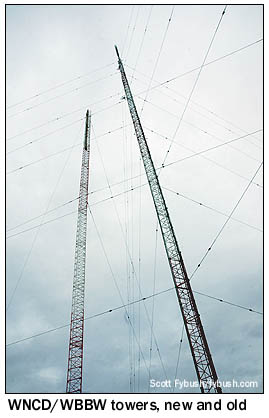
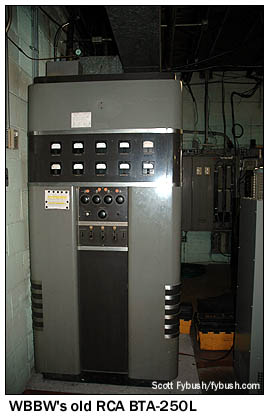 Some cities never
seem to have much change when it comes to broadcast facilities
- Boston, for instance, hasn't seen a completely new tower go
up in decades.
Some cities never
seem to have much change when it comes to broadcast facilities
- Boston, for instance, hasn't seen a completely new tower go
up in decades.
Others seem to have something new to offer every time. Better yet, some communities also have broadcast engineers with a keen sense of history, who are eager to show off their new - and old - facilities to an interested visitor.
One of those communities is Youngstown, Ohio, 70 miles southeast of Cleveland and about the same distance northwest of Pittsburgh, and not far out of the way on our regular jaunts to the midwest.
Such a jaunt took place over Labor Day weekend, 2006, as we headed to Akron, Ohio for this year's National Radio Club convention.
One of the club's regulars is Jerry Starr, veteran engineer and air personality at Youngstown's WHOT - and he had a busy menu of tours arranged for us on the way to the convention Friday morning. We'll get to Jerry's own sites in next week's Site of the Week installment, but we'll begin this week where we started that morning, across town at the Clear Channel transmitter sites, in the company of their market chief engineer, John Clarke.

|
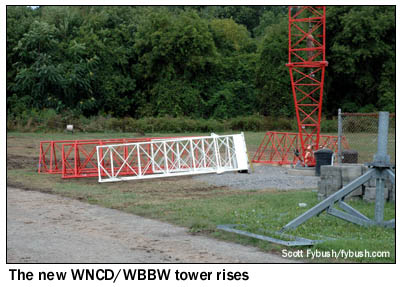
|
We met John on the north side of Youngstown, on Knox Street, where a 400-foot guyed tower has been home since 1968 to WBBW (1240) and its former FM sister, the class B station on 93.3 known over the years as WBBW-FM, WQOD, WBBG and now as WNCD. That tower is nearing the end of its useful life, and when we visit, a crew is at work building a new tower right next to it. When it's done, the old tower will come down, but in the meantime there are some interesting transitional moments. The 1968 tower was built the same way any combination AM/FM tower would have been built back then: base-insulated, with Austin transformers to get the power across the base to the lights. The new tower will be grounded at the base, with a folded dipole strung along the side for the AM antenna. And since you wouldn't want to build a new tower just a few feet from an old one that's hot with a kilowatt of RF at 1240 kHz, WBBW's not even on the air from this site at the moment. (We'll see where it's temporarily situated in next week's episode...)
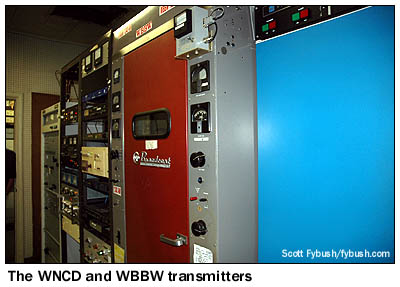
|
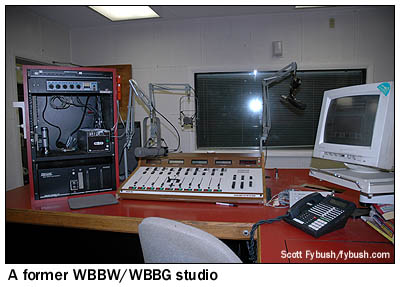
|
In the meantime, there's still plenty to see inside the building, even though it's no longer an active studio facility for anyone. (WBBW moved out when it was sold to Cumulus a few years back, and WBBG/WNCD moved south to the new Clear Channel studio complex in suburban Boardman when it opened in the late nineties; it was later leased out to another AM station, but they've moved out now, too.)
WBBW's old RCA BTA-250L is sitting out in the garage awaiting a new life as a ham rig, right next to the new WNCD antenna bays that will go up on the new tower. Inside the building, WBBW's more recent RCA sits quietly in the transmitter room with WNCD's Harris transmitters - and they're about the only signs of life in a building that's otherwise dark and mostly empty these days.
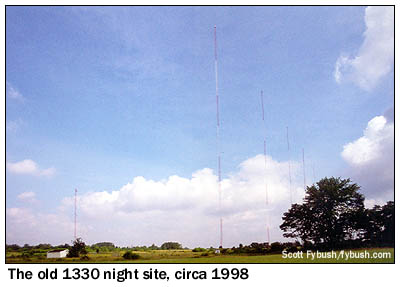 From
Knox Street, we head south (passing under the guy wires of the
WFMJ-TV 21 tower, which actually cross over I-680!) to Boardman,
then east to the town of Poland, where the area around Western
Reserve Road and Beard Road has become something of the AM tower
capital of the market.
From
Knox Street, we head south (passing under the guy wires of the
WFMJ-TV 21 tower, which actually cross over I-680!) to Boardman,
then east to the town of Poland, where the area around Western
Reserve Road and Beard Road has become something of the AM tower
capital of the market.
Some history here - we like that, after all: the first set of towers out here was the five-tower array shown above at left, which was built on Calla Road to provide a night signal for the market's screaming top 40 station, WHOT, when it went full-time in 1963.
WHOT had already become a dominant market force as a kilowatt daytimer on 1570, and AM was valuable enough back then that it was worth adding four more towers at the day site and building five 400-foot towers way down here for night use, in order to move WHOT to 1330 fulltime, with 500 watts by day and a kilowatt at night.
WHOT moved to an even better facility, the old WFMJ on 1390, in 1990, at which point 1330 went to new owners. (Keep the 1390 dial position in mind; it will play a role in our story later on!)
In time, the night site in Poland became more valuable than the AM license, and today the Poland towers are gone and 1330 (as WGFT) operates fulltime from the old day site in Campbell, northeast of Youngstown.
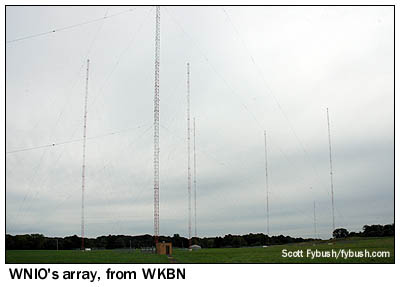
|
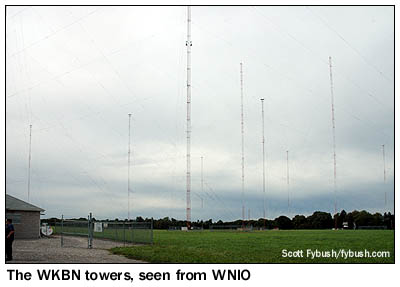
|
Before the old WHOT night towers went away, though, they were briefly part of a magnificent cluster of seventeen AM towers out here. For that story, we have to back up a bit: to 1977, to be precise, when one of the city's heritage stations, WKBN, wanted to build a new guyed TV tower behind its studio facility on the south side of Youngstown. That land already held a self-supporting tower for WKBN-TV and WKBN-FM, as well as the directional array for WKBN(AM), with 5 kilowatts day and night on 570. To make room for the new TV tower, the AM sticks had to move - and they moved right down here to Poland, in the form of six 430-foot towers with little capacitance hats on them.
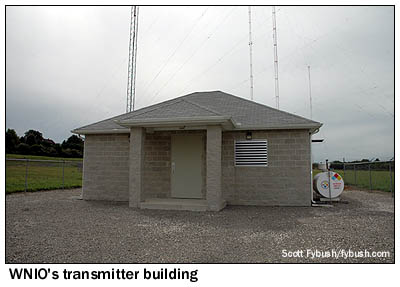 On
a nice clear day, drivers heading down Western Reserve Road could
see the six WKBN towers and the five WHOT night towers forming
what appeared to be an eleven-tower array. It was pretty neat
- but so is the current configuration at the WKBN site.
On
a nice clear day, drivers heading down Western Reserve Road could
see the six WKBN towers and the five WHOT night towers forming
what appeared to be an eleven-tower array. It was pretty neat
- but so is the current configuration at the WKBN site.
This is where we return to the 1390 part of our story: the old WFMJ 1390 transmitter site was on US 224 in Boardman, a spot that was remote and rural when the station went out there in the forties, but which (stop me if you've heard this story before) ended up right in the midst of Youngstown's busiest suburban shopping strip a few decades later.
The land was sold (and in fact, later on this day we'd end up having lunch at a Wendy's right on that site), and WHOT (later WRTK) 1390 spent a few years broadcasting under special temporary authority from a short tower in a bad part of town.
It eventually ended up as WNIO (after swapping calls with the 1540 station up in Niles, which is now WRTK), under common Jacor/Clear Channel ownership with WKBN, and in 2003, it built a new six-tower night array directly adjacent to the WKBN site, just to the west along Western Reserve Road, creating a twelve-tower complex that's pretty remarkable even without the now-demolished WHOT night towers nearby.
Today, WNIO operates with 9500 watts by day from the former STA site, and 4800 watts at night from this site in Poland, with its six towers of varying heights. (In the array photo up above, the tower in the foreground is one of WKBN's, and you have to look very carefully to spot the short #6 tower - 208 feet - at the east end of the property; the old WHOT night site would have been just beyond the trees to the right.)
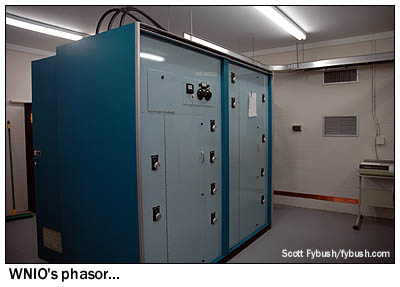
|
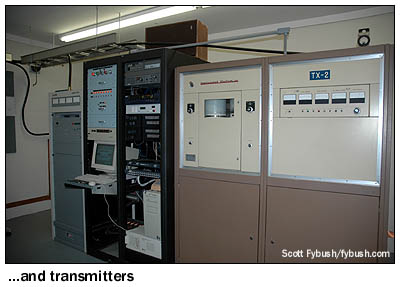
|
As long as we're over on this side of the property, we may as well show you the WNIO building first (though in real life, we began our tour this day on WKBN's side of the site): it's a very straightforward small building with a Kintronics phasor, a Harris main transmitter and a Continental aux that came from another Clear Channel station and has barely seen any use out here.
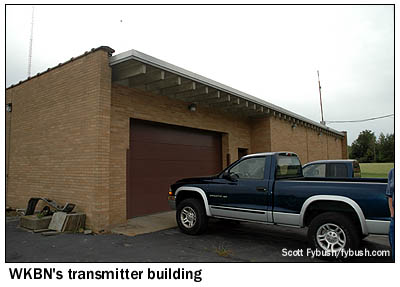 Another
small room holds a generator to keep WNIO on the air in the event
of power failure. That - plus a rack of STL and processing hear
- is pretty much it on this side of the property.
Another
small room holds a generator to keep WNIO on the air in the event
of power failure. That - plus a rack of STL and processing hear
- is pretty much it on this side of the property.
WKBN's building, reached via a long driveway next to an old farmhouse on the west side of the property, is somewhat larger and packed more full of gear.
There's a garage that's used for storage, which opens into a big room that houses the WKBN transmitters (an older Harris MW5 and the BE AM6 that's the primary), STL and processing gear, and a very well-organized collection of parts for all the transmitters out here.
A small room off to the side holds the generator, and behind the transmitters (which sit in a space that clearly once housed a much larger transmitter), there's another room that houses the open-air phasor for WKBN's 5 kW nighttime directional pattern, which protects the many other 570s in fine places like Syracuse, Yankton and Paducah. (WKBN is non-directional by day.)
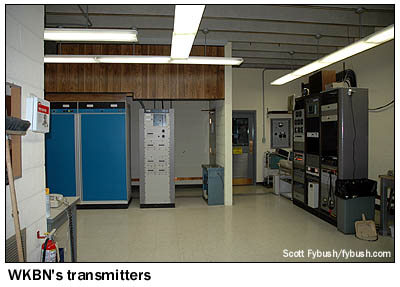
|
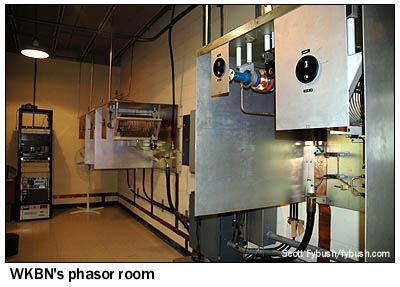
|
And after all this, we've just gotten started on our Youngstown visits. In next week's installment, we'll check out where WBBW's operating from these days (and where its original tower ended up), plus the market's first FM with HD Radio, and much more...
 The Tower Site
Calendar 2007 is here! They're selling fast - order today
at the Fybush.com
Store!
The Tower Site
Calendar 2007 is here! They're selling fast - order today
at the Fybush.com
Store!
- Previous Site of the Week: First Canadian Place, Toronto
- Next Week: WYFM/WHOT/WBBW, Youngstown, Ohio
- Site of the Week INDEX!
- How can you help support Site of the Week? Click here!
- Submit your suggestions for a future Site of the Week!
